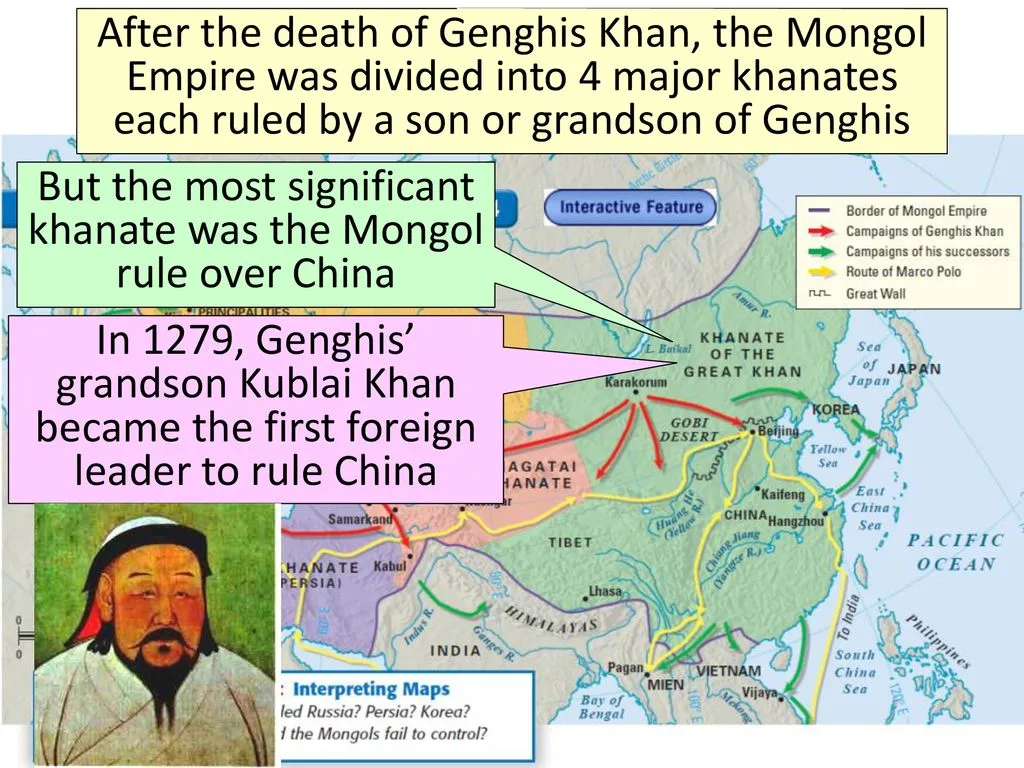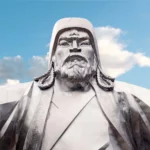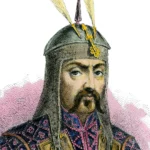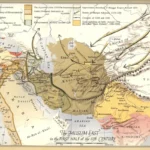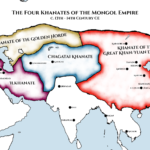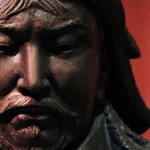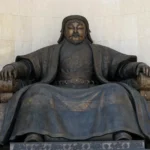Let’s explore the epic tale of Genghis Khan, the legendary leader who transformed the world’s map centuries ago. We’ll dive into his life and conquests, from humble beginnings to unmatched power, taking a thrilling journey through the rise and fall of the Mongol Empire. Buckle up as we uncover the secrets, strategies, and fascinating events that defined Khan’s legacy as one of the most iconic figures in history.
Genghis Khan: A Timeline of Epic Conquests and Empire
Imagine yourself transported back in time, to the vast and enigmatic steppes of Mongolia. Here, you’ll witness the rise and fall of one of history’s most awe-inspiring figures: Genghis Khan. Join us on an adventure through his thrilling timeline, where we’ll uncover the moments that transformed the world forever.
Temujin: The Orphan Who Became a Leader
Born in 1162 as Temujin, Genghis Khan’s early years were fraught with challenges. His father’s untimely demise left him as an orphan at a young age. But what he lacked in paternal guidance, Temujin made up for in resilience and cunning.
Unification of the Mongols: A Triumph of Diplomacy and Force
One of the most remarkable achievements in Genghis Khan’s life was his ability to unite the scattered Mongol tribes, a feat that had eluded many before him. Through a shrewd blend of diplomacy and military prowess, he formed alliances, outplayed his rivals, and forged a formidable force. By 1206, Temujin had emerged as the undisputed ruler of the Mongols and adopted the title “Genghis Khan,” meaning “universal ruler.”
Conquest and Empire-Building: A Trail of Triumphs
Driven by an insatiable thirst for expansion, Genghis Khan embarked on a series of military campaigns that reshaped the map of Eurasia. His armies marched with lightning speed, conquering vast territories that stretched from the Pacific Ocean to the Caspian Sea. Along the way, they toppled mighty empires like the Tangut kingdom of Xi Xia, the Khwarezmian Empire, and vast swaths of China, Russia, and Central Asia.
The Mongol Empire at Its Peak: A Hub of Exchange and Innovation
At the height of its power, the Mongol Empire under Genghis Khan’s leadership was a marvel of cultural exchange, trade, and technological advancements. It stretched across continents, connecting diverse civilizations and facilitating the flow of ideas and goods. Under Genghis Khan’s rule, the empire embraced religious tolerance and promoted meritocracy, fostering a vibrant and progressive society.
Legacy and Enduring Impact: A Symbol of Power and Transformation
Genghis Khan’s death in 1227 marked the end of his epic reign, but his legacy continued to shape the world long after he was gone. His successors inherited his military strategies and administrative systems, expanding the Mongol Empire even further and leaving an indelible mark on the course of history.
Genghis Khan’s story is one of extraordinary ambition and transformative leadership. His conquests left an enduring impact on the political, cultural, and economic fabric of Eurasia, shaping the destiny of nations and inspiring awe and respect for generations to come.
Keen to learn about the towering achievements of the enigmatic Genghis Khan? Dive into the chronicles of his extraordinary life and leadership by clicking here. Discover how he ascended to become the supreme ruler of the awe-inspiring Mongol Empire, forging a legacy that continues to captivate historians.
Uncover the intricate history of Genghis Khan and the Mongol Empire by delving into a captivating narrative filled with conquests, alliances, and cultural exchanges. Click here to embark on a journey through time and witness the rise and fall of one of the most influential empires in human history.
Witness the brilliance of Genghis Khan as a military strategist and leader through his insightful quotes on leadership, war, and life. Click here to explore his profound wisdom and gain a glimpse into the mind of this extraordinary conqueror.
Trace the path of Genghis Khan’s relentless conquests and witness the expansion of the Mongol Empire across vast territories. Click here to discover the remarkable military campaigns that shaped the political landscape of Asia and beyond.
Conquests and Empire-Building: Genghis Khans Military Campaigns and the Mongol Empire’s Expansion
Conquering the World, Step by Step
Genghis Khan wasn’t just any run-of-the-mill general. He was like a super-charged conqueror on steroids! His army was so unstoppable, it would make the Transformers look like wimps. They swept across vast territories, leaving a trail of conquest that would make Alexander the Great green with envy.
Siege Warfare… with a Twist
The Mongols weren’t afraid to go toe-to-toe with towering city walls. They weren’t just your average battering ram gang. They had catapults that could hurl boulders like they were child’s play. And their siege towers? They were like mobile fortresses that could scale walls and rain down terror from above.
Cavalry on steroids
Imagine a horde of warriors on horseback, arrows flying faster than a speeding bullet. That was the Mongol cavalry. They were so agile and relentless, it was like they had wings! Their arrows could pierce through armor like it was butter, and they could maneuver around the battlefield like it was a game of chess.
Mind Games
Genghis Khan knew that fear was a powerful weapon. He spread rumors of Mongol ferocity like wildfire, leaving enemies trembling in their boots. This clever psychological warfare often made cities throw open their gates without even putting up a fight. After all, who wants to mess with the boogeyman?
Key Takeaways
- Genghis Khan was the ultimate warrior-king, the one who turned the Mongol tribes into a global superpower.
- His military strategies were like a secret recipe for conquest: siege warfare, cavalry dominance, and a dash of psychological warfare for good measure.
- The Mongol Empire became the biggest thing since sliced bread, stretching from China to Europe. It brought people and cultures together, and even helped spread cool new inventions and ideas.
Remember, kids:
Even the most daunting obstacles can be conquered when you’ve got a powerful army, a cunning mind, and the determination to rule the world. So, next time you’re feeling like a small fish in a big pond, just channel your inner Genghis Khan and go for it!
Legacy and Impact: Genghis Khan’s Death and the Mongol Empire’s Enduring Influence
Genghis Khan’s death in 1227 marked a major turning point in history, shaping the fate of the Mongol Empire he had built. His vast realm, stretching from Asia to Europe, stood as a testament to his military genius and leadership.
A Global Empire with a Profound Legacy
The Mongol Empire, under Genghis Khan’s rule, spanned a whopping 12 million square kilometers, connecting vast regions that had previously been isolated. This had a transformative impact on global trade, allowing goods and ideas to flow freely across Eurasia. The empire’s advanced transportation system, known as the Silk Road, facilitated cultural exchange and knowledge transfer between different civilizations.
Masterful Military Tactics
Genghis Khan’s military strategies were legendary. His warriors were renowned for their discipline, speed, and ruthless efficiency. They used cavalry to great effect, executing lightning-fast maneuvers that overwhelmed their enemies. The Mongols’ siege warfare tactics were also highly sophisticated, empowering them to conquer even heavily fortified cities.
A Legacy that Endures
Genghis Khan’s empire did not last forever, but its legacy continues to shape the world today. His descendants ruled over vast territories for centuries after his death, and his influence can still be seen in the political and cultural tapestry of Central Asia. From the descendants of his generals who established the Mughal Empire in India to the Mongolian rulers who govern modern-day Mongolia, Genghis Khan’s vision of a united and powerful Mongol nation has had a profound and lasting impact.
The Pax Mongolica: A Flourishing Period
Under the Mongols’ rule, a period known as the Pax Mongolica emerged. This time of relative peace and stability allowed for unprecedented intellectual and artistic advancements. Trade routes were safeguarded, fostering economic growth and cultural exchange. The Mongols’ patronage of the arts and sciences attracted scholars, artists, and merchants from around the world, creating a cosmopolitan atmosphere that fostered innovation and creativity.
A Complex and Enduring Legacy
Genghis Khan’s legacy is complex and multifaceted. He was both a ruthless conqueror and a visionary leader who united vast regions under his rule. His military strategies and empire-building achievements continue to fascinate and inspire, while his impact on global history and culture is undeniable. From the rise of the Silk Road to the emergence of modern-day Mongolia, Genghis Khan’s presence can still be felt today, shaping the world in countless ways.
What are the key events in Genghis Khans life and their significance?
Picture this: a young boy, orphaned and alone, facing the harsh realities of the Mongolian steppes. His name was Temüjin, and his story is one of the most captivating tales of leadership, resilience, and conquest in human history.
1162: A Birth of Destiny
Temüjin’s birth into a royal clan was a bittersweet beginning. His father’s death set his family adrift, leaving him vulnerable and facing constant threats. Yet, in the face of adversity, Temüjin’s strength of character shone through.
1206: The Rise of Genghis Khan
As a young man, Temüjin’s charisma and strategic mind earned him the respect of the Mongol tribes. He united them under a single banner, and in 1206, was proclaimed Genghis Khan, the “universal ruler.”
1211-1223: Conquering Vast Territories
Genghis Khan’s armies swept across Eurasia, leaving in their wake a trail of conquered lands. His innovative tactics, like the use of cavalry and siege warfare, shattered the defenses of enemy empires. From the Pacific Ocean to the Caspian Sea, his conquests laid the foundation for one of the largest empires in history.
1219-1221: The Fall of the Jin Dynasty
Turning his attention to China, Genghis Khan’s armies laid siege to Beijing and captured the Jin Dynasty’s capital, Zhongdu. This victory cemented Mongol dominance over northern China, giving them control over vast wealth and resources.
1219-1224: Westward Bound
Genghis Khan’s ambitions extended beyond China. He led his armies westward, conquering Persia, Central Asia, and parts of Eastern Europe. These conquests expanded the Mongol Empire’s reach, connecting East and West along the Silk Road and fostering cultural exchange.
1227: The Legacy Lives On
Genghis Khan’s relentless campaigns came to an end in 1227 when he died during an expedition against the Western Xia. His empire continued to expand under his successors, reaching its peak under his grandson, Kublai Khan. Yet, Genghis Khan’s legacy as a transformative leader and military strategist continues to inspire and fascinate to this day.
FAQ
Q1: When was Genghis Khan born, and when did he establish the Mongol Empire?
A1: Genghis Khan was born in 1162 and established the Mongol Empire in 1206.
Q2: What were some of Genghis Khan’s most significant military victories?
A2: Genghis Khan’s most notable military victories include the conquest of the Tangut kingdom of Xi Xia, the Khwarezmian Empire, and parts of China, Russia, and Central Asia.
Q3: When did Genghis Khan die, and who succeeded him as the ruler of the Mongol Empire?
A3: Genghis Khan died in 1227, and his son, Ögedei Khan, succeeded him as the ruler of the Mongol Empire.
Q4: What was the extent of the Mongol Empire at its peak?
A4: At its peak, the Mongol Empire covered most of Eurasia, stretching from the Pacific Ocean in the east to the Adriatic Sea in the west.
Q5: What was Genghis Khan’s legacy, and how is he remembered today?
A5: Genghis Khan is remembered as one of the greatest military leaders in history. His empire had a profound impact on the political, cultural, and economic landscape of Eurasia, and his legacy continues to be debated and studied today.
- Unveiling the Enigma: Mansoureh Khojasteh Bagherzadeh’s Public Appearances & Private Life in Iran - July 18, 2025
- Unveiling the Mystery: Mansoureh Khojasteh Bagherzadeh’s Husband: A Rare Glimpse into a Private Life - July 18, 2025
- Unveiling Masoud Khamenei’s Mother: Power, Influence, and Iran’s Future - July 18, 2025
